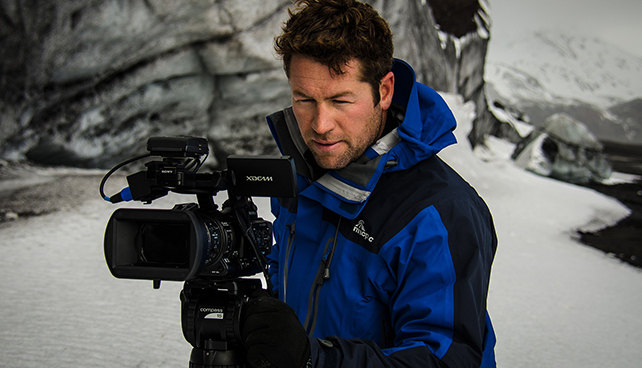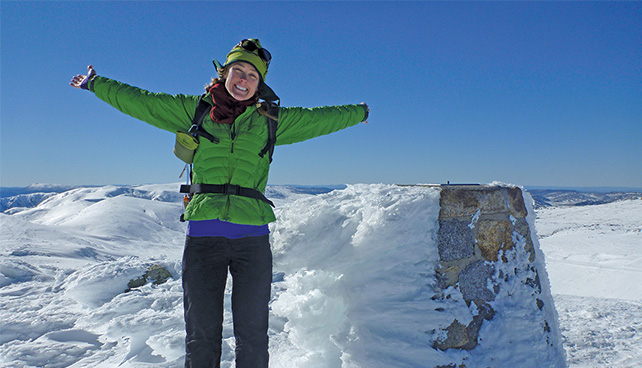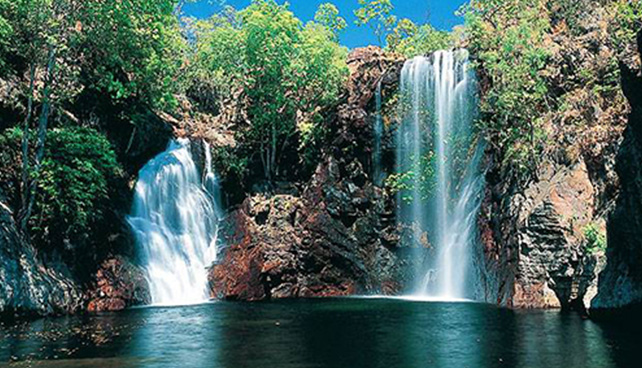There are very few places in Australia I have found that feel so wild, so remote, so ancient and so untouched. If I tell you we spent seven days exploring the McIllwraith Range you will most likely say: Never heard of it, where’s that? At least that is what I said when I first found out about this little known, and rarely visited part of the Cape York peninsular in far north Queensland. The range itself is a big geological feature covering about 3000 sq kms and lying 15km east of the town of Coen, and 550 km north of Cairns.
The landscape is vastly different to anywhere else in Cape York. Elevated mountain peaks of up to 824m spawn rainforest communities that flow down escarpments and into valleys where rich river systems flow and separate vast open areas of bushland. The rainforest looks very different to that of the Daintree Rainforest for instance, and with very good reason. It has closer ties to Papua New Guinean rainforest and represents the most southern limit for many plants and animals from there.
It is this landscape that we are lucky enough to traverse under the special guidance of traditional owners Dion Creek and his brother Amos Hobson from Southern Kaantju and Uutaanlanu country. This area cannot be accessed in any other way and we feel extremely privileged and humbled of the invitation to show us their connection to country and coast. To do this however is no mean feat, especially given the remoteness of the location, the extreme nature of the land, and time since the track has been pushed through. This area has experienced multiple wet seasons and cyclones since the last visit about four years ago and so old tracks were overgrown, washed away, heavily rutted or simply not visible anymore. Only a special type of vehicle then can make this journey; the ATV.
Our mission was simple; to see and experience as much of the McIlwraith Range as we could in seven days to document this little known and accessed part of Australia. The first portion of this was to explore some of the highland areas, while the final push was a 200km return trip out to the coast and back along the northern foothills of the range.
Our first forays into the highlands were tough and slow going. Overgrown tracks, fallen trees and hot conditions meant we could penetrate only so far on the limited trails available during three individual day trips. We pushed as far as we could and on our last day in this region ended up at a stunningly beautiful rainforest creek. Instantly a fire was lit by Dion in the preparation of freshly caught black bream by the rangers who leapt out of the side by side with their hand lines and baits. It didn’t take long before we were all feasting on the fat filled little fish that were nothing short of delicious! It was a great way to end to this part of the expedition.
The coast run was the part I was most looking forward to though. A four day return trip through spectacular country with just the equipment we could carry on the bikes for survival. It was the test I had been wanting ever since starting to ride ATVs and realising just how useful they could be in getting to remote and hard to get to places.
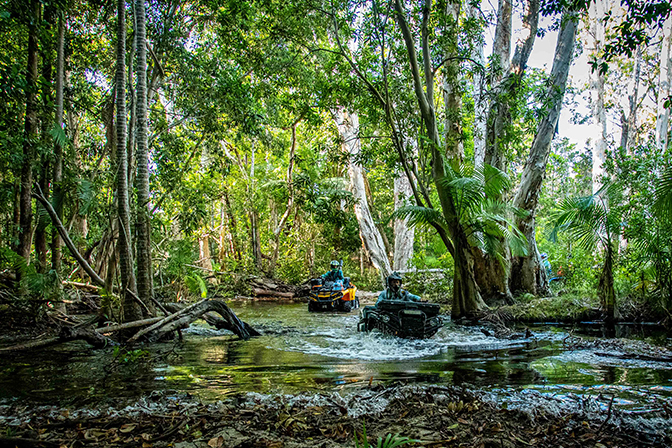
One of the things that really struck me was just how well Dion and Amos knew this country. Without maps or GPS they seemed to navigate through generations of ancestors walking and living on this land. Tiny changes in vegetation, a rock that geologically had no place in being there, a story that connected one place or person to another, and a sense of direction that can only be attained with sensing every part of the terrain meant that we weaved our way across 100s of kilometres over the seven days seamlessly. However the landscape itself is unforgiving and hot, with limited freshwater access sometimes separated by 30-40kms. Thankfully both Dion and Amos knew exactly where all of these were and how reliable they would be for topping up water supplies at this time of year. If I was left to navigate here with no maps or GPS I would be worried in my ability to get to the next waterhole, especially if we broke down and had to walk. After years exploring everywhere from the Antarctic to the Arctic and everywhere in-between I still think I would have struggled here on my own, and I feel like I have fairly good bush skills.
Along our journey to the coast both Dion and Amos stopped at regular intervals to interpret the land, the country and the culture. For this we were deeply appreciative and in my mind this was the best part of the expedition. In these sessions we learned of the rich aboriginal culture that called this place home for thousands of years, of Dions and Amos’s grandfather Thomas Creek and how he had escaped the missions and walked back home through this landscape, of the rights and rituals that had taken place, and of the plants and animal that could be relied upon for food, medicines and equipment. Just as we know the isles of our local food and hardware stores, so do the traditional owners of this land know the bush in the same ways. Knowing that is one thing - seeing it in action is definitely something else all together.
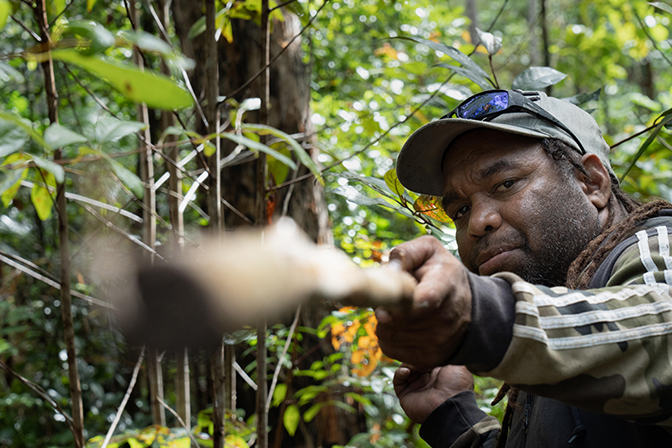
Our first camp was in a wide sandy river bed at Attack Creek, so called for an aboriginal attack on explorer and state geologist Robert Logan Jack in 1879 as he and his team searched for new goldfields throughout Cape York. Given we were now officially entering Dion's grandfather's country, Ngaachi Kaantju, a ceremony was conducted that would mean the spirits and ancestors of the land would know we were travelling with Dion and Amos, that we were friends and not foe, and that we would be looked after on our journey. This consisted of Dion passing to us his smell. A smell that had been passed on through generations of Dions lineage over thousands of years and as a way of recognising ‘self’. By rubbing his hands under his arms and onto our hair and bodies Dion had symbolised to the spirits and to us that we were one of ‘him’. Each one of us underwent this ancient practice in silence under the gaze of gigantic rainforest trees that lined the banks as Dion welcomed us to his peoples country.
It's hard to describe the feeling of being part of a ceremony like this, or being welcomed in such a personal manner, but the words humble, acceptance and respect, come to mind. I wish my own family and culture had such beautiful ways of making us and others feel as welcome as I did in this one simple gesture, but we don’t, and for that I feel little or no connection to the land I was born on or my ancestors that had come before me. In so many ways it makes me incomplete, especially as a lover of the natural world.
With our tents pitched, and food cooked it was time to take in where we were. A fire was lit with the setting of the sun and our weary bodies bathed in its light until an entire universe of stars emerged between the outstretching limbs of the canopy above. Many stories were told, and friendships were forged.
The next day we broke camp and hit the trail for another full day of riding with about 60km to cover to get to the coast. Throughout the day the terrain seemed to once again repeat itself over and over again. Large expanses of open bush areas interspersed with low lying rivers or creeks, and steep rainforest climbs and descents. It all made for adventurous riding and that feeling of getting more and more remote grew stronger as we ventured ever closer to the coast.
Throughout the day Amos’s excitement grew for our final destination and he reminisced about his last trip to his favourite spot on the beach we were headed for. He enthusiastically told us stories of an untouched coastline with endless bounties of huge mud crabs, black lipped oysters the size of your hand, crocodiles as long as mini vans, and estuaries so full of fish you could catch as many as you wanted. The image he was constructing in our minds was of a place we didn’t think existed anymore. A place that nobody accessed and that was as close to ‘wild’ as it could be. Clearly our excitement also grew along with his, and as we finally hit the soft sands of the beach that night after 11 hard hours on the trail, we couldn’t wait to see what all this looked like in the morning. Amos selected a camp away from the waters edge and right there he lit one last spot fire in the coastal scrub to scare away any snakes and deter curious crocodiles. With exhausted bodies we clumsily made camp, ate a simple meal, fell into our tents and drifted off to sleep.
Amos suggested we first go fishing in the river mouth just to the north. Then when the tide was at its lowest we would harvest oysters and spear mud crabs. This was starting to sound pretty exciting. We followed Amos up the beach until we reached a wide river that snaked and cut its way through steep sand banks to the beach. Upstream both sides were flanked with thick mangroves. Despite very fresh and might I add a very large crocodile slide right there, Amos got straight into fishing with his spear and hand-lines while in knee deep water. Upon questioning him about how safe that was he eluded to just knowing that it was ok there, that the crocodile was not interested in him or us and that growing up around these animals had given him an awareness we might not comprehend. I too live in crocodile country and my crocodile awareness i'll admit is very high. I wasn’t going to go in the water, nor were the others and Leon and Darrock used more conventional rods and reels along the safety of the banks.
In no time at all we had a barramundi and a mangrove jack which was no surprise given we could simply see so many of these two species lazily swimming around. In fact I have never seen a river so simply full of life in Cape York as most of the accessible spots are heavily fished. Clearly this was somewhere very special.
The rest of our day was spent exploring this remote beach which was about 6km in length. To the north was an impassable river mouth, to the east was the far northern section of the Great Barrier Reef, to the south was a rocky headland, and to the west was the mighty McIlwraith Range. But right here on the coast were slight intricacies that I would have failed to find. Amos knew this place like the back of his hand. I know that sounds cliche but it really was the case.
He took us to other favourite fishing spots, to permanent freshwater springs of great cultural significance, and to long forgotten camps of his grandfather and family where he fondly reminisced of being a young boy here and playing with his brother Dion. The beach had quickly gained a special place in our hearts too, for many reasons but none more than being here with Amos and being guided physically and spiritually to what life here has been like for so many of his people that had come before us.
Tomorrow we would head back along the trail we had come in on, and this place would just be a memory. But for our last night here, sitting by a crackling fire with the simplest of necessities and new friends, and bellies full of rich seafood, I was as close as I have come to a life my DNA longs for. A life of full connection with the rhythms and harmony of nature and living on and with the land. A life that first nation Australians have always known. It's with great thanks that through Amos and Dions' generosity and willingness to share their country, that we got to experience the mighty McIllwraith, and culture, first hand.
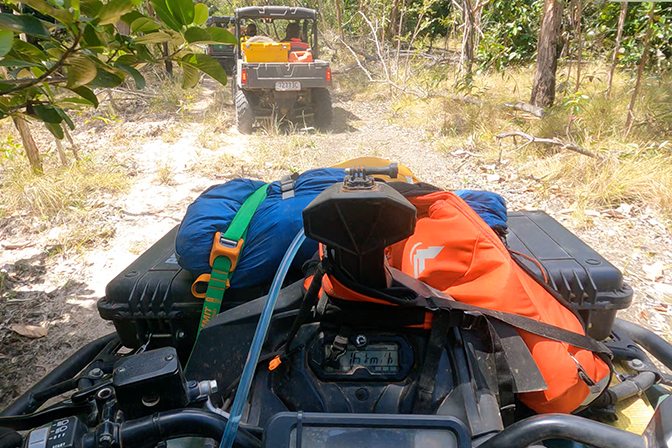
Special thanks
Special thanks to Can-am, Anchorline, Macpac, Pelican, Uniden, Aussie Powersports, Warn Winches, Duncan Powersports, FatMap, Kimberley2Cape, Tyrepower Cairns, Tackleworld Cairns, River Bend Canvas and Urban Wheelz for products and support to make this expedition possible.

